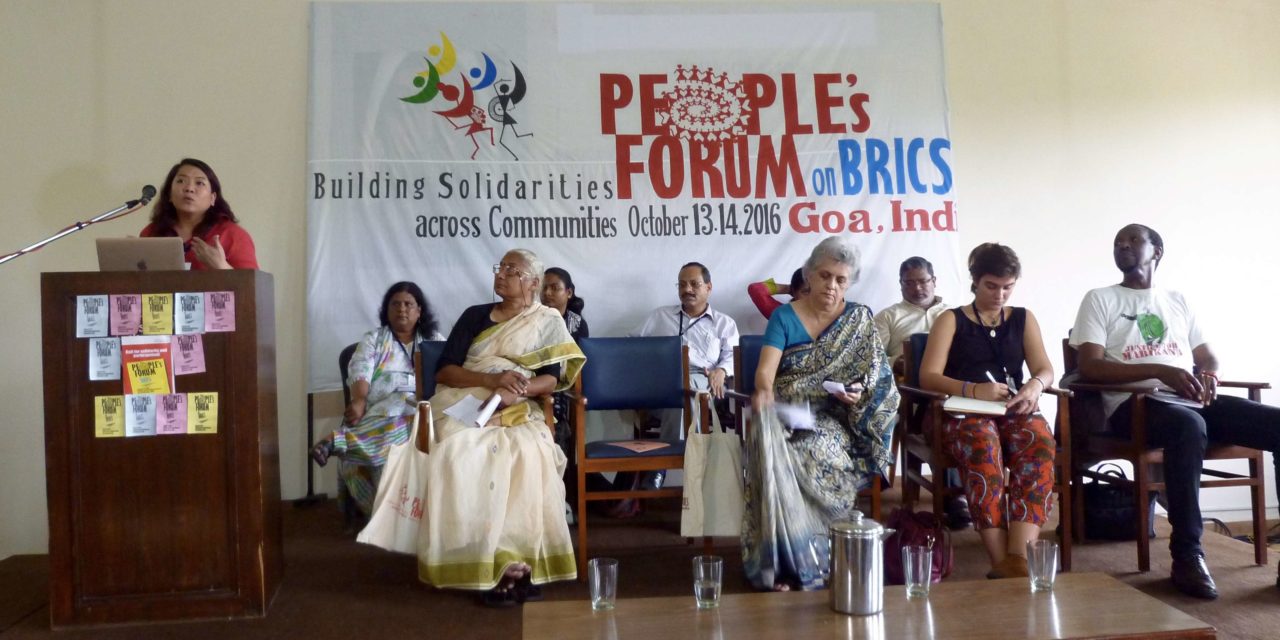Does BRICS still offer an alternative model of development that can address the current global crisis? Is this grouping of the emerging economies of Brazil, Russia, India, China, and South Africa actually challenging the hegemony of the old powers for the benefit of the rest?
These were the main questions raised in the recently held two-day “People’s Forum on BRICS,” held in Goa on October 13 and 14, attended by more than 500 representatives of various mass organizations, people’s movements, community-based, and social justice groups from 10 countries and around 25 states in India.
There was a strong interest to understand China’s new role in the global political economy and in how to engage and confront the growing operations of Chinese and BRICS transnational corporations or TNCs. People in Goa were also particularly concerned about the impacts on their livelihoods of the growing number of Chinese TNCs in their state and in India in general. There were questions too on whether China as the most economically powerful BRICS country has become a new imperialist or a sub-imperialist country that is actually supporting the status quo of elite dominance.
The environmental footprints and social impacts of Chinese TNCs are increasing due to the growing expansion of their operations in developing countries in Asia, Africa, and Latin America, as well as in old centers of capitalism Europe and the US. For many countries, the Chinese have been making more affordable goods available. However, Chinese investments and finance capital are also carving out territories for oil, coal, minerals, and other important resources. Representatives from the National Hawkers Federation who attended the forum share the perspective that the flooding of cheap Chinese products in markets are killing or bringing down small and local businesses and producers.
The Rise of Chinese TNCs
China is now second to the US in having the biggest number of TNCs that made it to the list of the 2015 Fortune Global 500. It has consecutively landed second in the list of TNC host countries for the last five years. This year’s ranking of the biggest, most powerful, and richest corporations that control the movements of wealth and resources listed 106 Chinese TNCs (including those based in Hong Kong) compared to 128 American-owned TNCs. Between the years 2000 and 2010, there were 10 Chinese TNCs compared to 170 TNCs from the US and 46 Chinese TNCs and 139 US TNCs respectively. The spectacular growth of Chinese global corporations in the short period after 2010 to today is indeed admirable.
The biggest corporation in the ranking is US-based Wal-Mart Stores Inc. which had a total revenue of $485.6 billion in 2014 followed by the State-owned company China Petrochemical Corporation or better known as Sinopec, which earned $446.81 billion. Sinopec has outranked Royal Dutch Shell, which is formerly second in revenues and now third in the list.
It is important to understand Chinese TNCs and the way they operate. It is worth noting that the majority of the listed 106 Chinese companies are state-owned, with 47 directly under the control of the State Assets Supervision and Administration Commission or SASAC in China and only 22 are private corporations. Chinese State-Owned Enterprises or SOEs are different from usual corporations. The Communist Party of China normally appoints the top executives, including the Chief Operating Officers (CEOs) of SOEs as well as of the biggest state-owned banks. Informally, SOE executives have close ties with top government officials. At the lower levels, the management of local SOEs are also beholden to local Communist Party leaders.
The Chinese government has absolute control or has more than 50 percent ownership stakes in the primary firms in the industries of coal, oil, electricity, defense, telecommunications, air transport, and ocean shipping. SOEs provide the largest job opportunities in the country, with Sinopec employing, for instance, 18.7 million employees.
China’s Way of Economic and Development Planning
In China, state enterprises dominate many segments of the economy. Their growth is in line with the long-term economic and development planning of the government. To know China’s economic thrusts, one has to pay attention to its Five-Year Plans.
In October 2015, the 5th Plenum of the 18th Central Committee of the Communist Party of China had adopted the Blueprint for China’s 13th Five Year Plan for Social and Economic Development (13th -FYP from hereon), which would cover the period 2016 to 2020. The National People’s Congress unveiled it last March. The 13th -FYP is the first five-year plan formulated under President Xi Jinping’s leadership. It is strategically important because the year 2020 is the 100th founding anniversary of the Communist Party of China and the deadline for realizing China’s development goal of a “moderately prosperous society” in all aspects.
Apart from having an ambitious promise of “Prosperity for the Masses in 2020,” the 13th -FYP also has many other important targets, especially on environment and energy development. The Chinese government is aiming to double its GDP levels and the country’s per capita income at 2010 levels by 2020 and to eradicate poverty. To do this, a comprehensive plan for embarking on what will be China’s economic “new normal” will be realized through an industrial transformation. One key target is to end the current reputation of Chinese products as cheap and low quality.
Chinese government planning tends to be long-term and strategic where state resources are mobilized to realize the plans. It also benefits from the fact that there is no imminent challenge to the rule of the Communist Party. The13th -FYP is a continuation of an earlier medium-term state sector and industrial policies for 2006 to 2020, which enjoyed significant government expenditures directed at creating market viable products and enterprises. The planned “New Normal” in 13th -FYP aims to upgrade China’s position in the global value chains by cultivating strengths in technology, standards, brands, quality, and service.
China and BRICS and Current Global Challenges
The world economy is on the verge of another financial meltdown and this is causing stocks and currency market crisis in many of the BRICS countries, especially China. The current crisis of capitalism could be a long-term crisis and the indicators are already evident such as the huge slowdown in international trade and increasing decline of global profit rates and business disinvestment. Three of the members of BRICS are already suffering negative or negligible GDP growth. Among the Chinese TNCs in Fortune 500’s list, 13 companies have suffered the greatest losses this year.
To respond to the crisis and to avoid the “middle income trap,” China would need to maintain an annual average GDP growth rate of 6.5%. The target for this year is between 6.5 and seven percent. This growth rate should also be complemented by a smooth transition to a growth model primarily driven by consumption and services. China’s most comprehensive and ambitious industrial plan, the “Made in China 2025 Plan” is to upgrade in priority strategic industries such as next-generation information technology, aerospace, railway and power equipment, high-tech ships, and energy-saving vehicles and products, etc.
The People’s Forum on BRICS participants argued that China’s planning and success although beneficial to many the Chinese people was resulting in injustices and violations of rights and environmental standards in the other BRICS countries, the rest of the developing world and even in China itself. During the said gathering, there was recognition that although it was the responsibility of the governments to bargain and get the best deals from Chinese investments, Chinese SOEs should be more responsible. Unfortunately, people to people links between Chinese and social movements in other BRICS countries are weak.
It was noted in one of the workshops that the BRICS New Development Bank had been working hand-in-glove with the World Bank and that the Contingent Reserve Arrangement empowered the International Monetary Fund. Indeed, China’s increased voice in the IMF also resulted in the lowering of votes of other developing countries, especially in Africa and even South Africa. It has also been alarming that the Asian Infrastructure Investment Bank seems to be serving mainly corporate interests. It is already lending even before transparency mechanisms have put in place.
China and the BRICS’ new role in the South is also not helping democracy. No leader or party in BRICS, for instance, has denounced the undemocratic impeachment of the democratically elected Brazilian president Dilma Rouseff. BRICS and Chinese TNCs are also propping up dictators and through this indirectly aiding repression. Chinese TNCs’ new power, oil, and other fossil-fuel companies (whether private or state-owned) engage with impunity and are misbehaving like other “old” TNCs in the same fields do.
Indeed, China is not bringing down neoliberal capitalism, is not forwarding systemic alternatives, and is unlikely to do so since it also follows similar paths of development as the old powers. It is not presenting an alternative to hegemony or talking about changing the world economic system. Its actions show it merely wants to have greater influence and space within the existing system. It is not also ensuring that the voices of grassroot communities and civil society are heard.
Deng Xiaoping said in his 1974 speech to the General Assembly of the United Nations: “If one day China changes her color and turns into a superpower, if she too should play tyrant in the world, and everywhere subject others to her bullying, aggression, and exploitation, the people of the world should identify her as social imperialist, expose it, oppose it and work together with the Chinese people to overthrow it.”
Ms Guerrero works with Focus on the Global South and Transnational Institute








